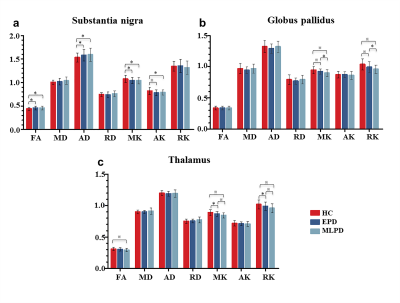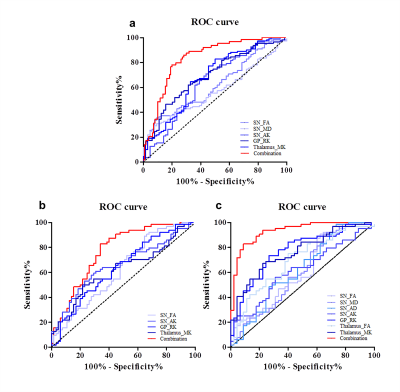Xueqin Bai1, Tao Guo1, Xiaojun Guan 1, Cheng Zhou1, Jingjing Wu1, Xiaocao Liu1, Ting Gao1, Luyan Gu1, Xiaojun Xu1, Peiyu Huang1, and Minming Zhang1
1The second Affiliated Hospital, Zhejiang University School of Medicine, Hangzhou, China
1The second Affiliated Hospital, Zhejiang University School of Medicine, Hangzhou, China
In this study, we employed diffusion kurtosis imaging (DKI) and diffusion
tensor imaging (DTI) to measure the microstructural alterations in subcortical
nuclei across PD patients at different disease stages. Individual diagnostic
model was constructed to test the performance of diffusion metrics in
identifying PD patients at different stages.
We found that PD patients at
different stages have progressive microstructural alterations in the main nuclei of widely
acknowledged nigral-pallidal and thalamo-cortical pathways. DKI is sensitive to detect microstructural changes
in GP and thalamus between early stage PD and moderate-late stage PD patients.
The combination of kurtosis and tensor metrics can achieve a good performance in
diagnosing PD.

Figure 2. Mean diffusion metrics in healthy controls (HC),
early-stage Parkinson’s disease (EPD) group, and moderate-late-stage Parkinson’s
disease (MLPD) group. (a) Mean diffusion metrics in substantia nigra (SN) in HC, EPD, and MLPD. (b) Mean
diffusion metrics in globus pallidus (GP) in HC, EPD, and MLPD. (c) Mean
diffusion metrics in thalamus in HC, EPD, and MLPD. * and※ indicate p <
0.05 and p < 0.01.

Figure 4.Receiver operating characteristic curves of the
diagnostic performance of diffusion metrics in substantia nigra(SN), globus
pallidus(GP), thalamus and their combinations for discriminating Parkinson’s
disease (PD) patients from healthy controls (HC) or between early-stage
Parkinson’s disease group (EPD) (and moderate-late-stage Parkinson’s disease
group (MLPD)) and HC. Plots of the FA, AD, MD, MK, AK in the SN and MK, RK in the GP and FA, MK and RK values
in the thalamus and their combinations for diagnosing PD (a), EPD (b), and MLPD
(c).
